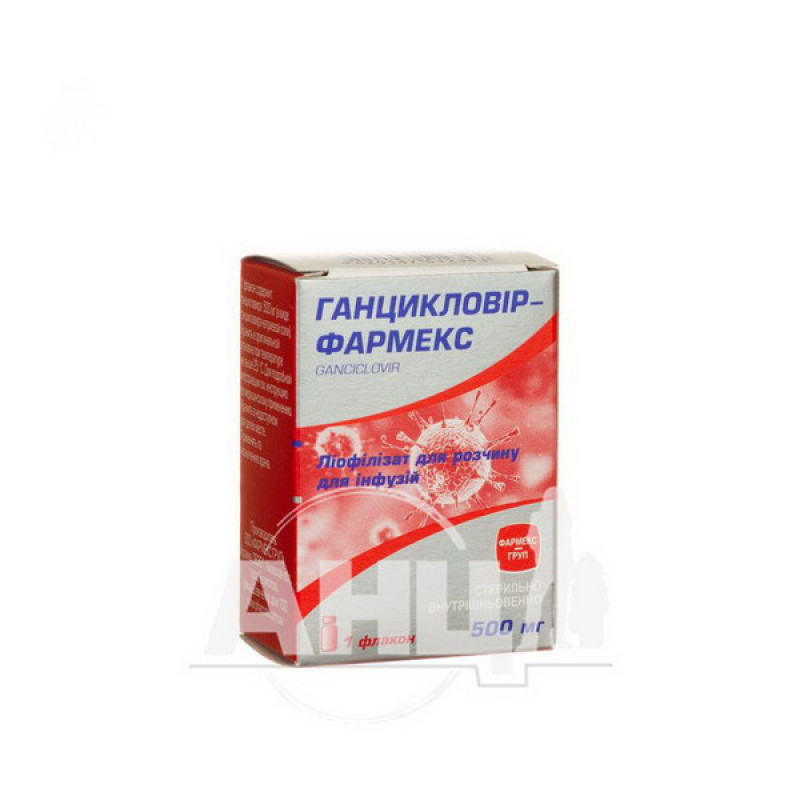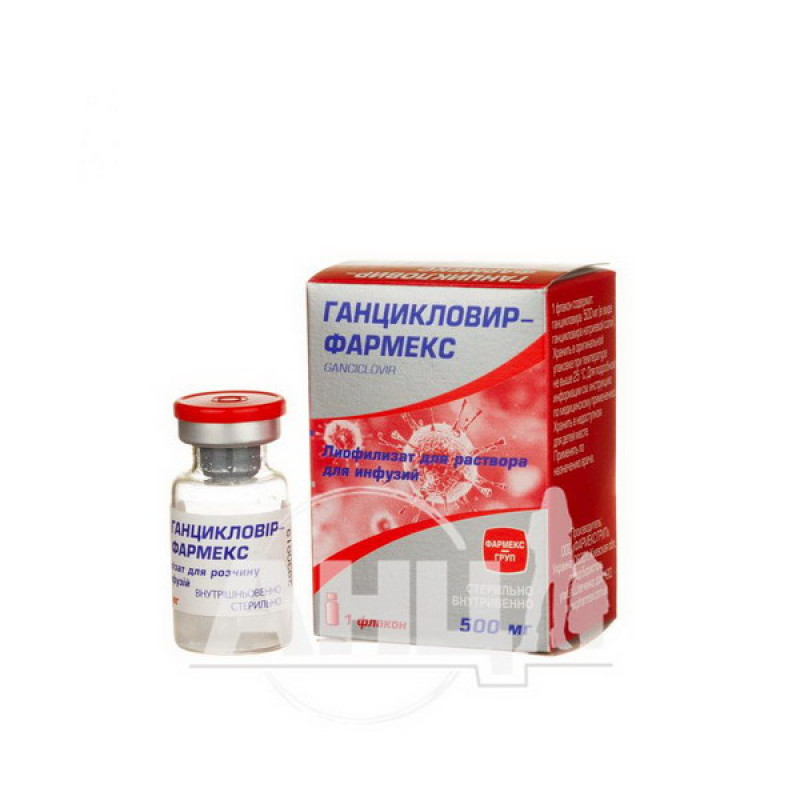Ganciclovir-Pharmex lyophilized powder for solution for infusion 500 mg vial No. 1

Ganciclovir-Pharmex is indicated in adults and adolescents ≥ 12 years of age for:
Treatment of cytomegalovirus (CMV) infection in immunocompromised patients; prevention of CMV infection by preventive therapy in patients with drug-induced immunosuppression (e.g., after organ transplantation or cancer chemotherapy).Ganciclovir-Pharmex is also indicated in children from birth for the prevention of CMV infection by universal prophylaxis in patients with drug-induced immunosuppression (for example, after organ transplantation or cancer chemotherapy).
Composition
Active ingredient: ganciclovir;
1 vial contains ganciclovir 500 mg (as ganciclovir sodium salt).
Contraindication
Hypersensitivity to ganciclovir, valganciclovir or any other component of the drug.
Breastfeeding.
Method of application
Caution: Ganciclovir should be administered by intravenous infusion over 1 hour at a concentration not exceeding 10 mg/mL. It should not be administered by rapid or bolus injection, as ganciclovir toxicity may increase due to excessive plasma levels.
It should not be administered by intramuscular or subcutaneous injection as this may result in severe tissue irritation due to the high pH (11) of the ganciclovir solution.
The recommended doses, frequency, or rate of infusion should not be exceeded.
Ganciclovir-Pharmex is a lyophilisate (powder) for preparation of solution for infusion. After reconstitution, Ganciclovir-Pharmex is a colorless to light yellow solution, practically free from visible particles.
The infusion should be given into a vein with adequate blood flow, preferably through a plastic cannula.
Application features
Pregnant women
Ganciclovir should not be used in pregnant women unless the clinical need for treatment outweighs the potential teratogenic risk to the fetus.
Children
There is limited experience in treating children under 12 years of age.
Drivers
The use of ganciclovir may significantly affect the ability to drive and use other machines.
Overdose
Cases of overdose with ganciclovir (some fatal) have been reported during clinical trials and post-marketing use. Most reports were not associated with any adverse reactions or included one or more of the adverse reactions listed below:
hematological toxicity: myelosuppression, including pancytopenia, leukopenia, neutropenia, granulocytopenia, bone marrow failure; hepatotoxicity: hepatitis, liver dysfunction; renal toxicity: increased hematuria in patients with pre-existing renal dysfunction, acute renal failure, increased creatinine levels; gastrointestinal toxicity: abdominal pain, diarrhea, vomiting; neurotoxicity: generalized tremor, convulsions.Ganciclovir is removed by hemodialysis; therefore, hemodialysis may be used to reduce plasma levels in patients who have received excessive doses.
Side effects
Note: Valganciclovir is an inactive form (prodrug) of ganciclovir, and adverse reactions associated with valganciclovir can be expected with ganciclovir. Oral ganciclovir is no longer manufactured, but adverse reactions reported with its use can be expected in patients receiving intravenous ganciclovir. Therefore, the list includes adverse reactions that have been observed with intravenous or oral ganciclovir or valganciclovir.
In patients treated with ganciclovir/valganciclovir, the most serious and common adverse reactions were neutropenia, anemia, and thrombocytopenia.
Interaction
Probenecid. The use of probenecid with oral ganciclovir resulted in a statistically significant decrease in renal clearance of ganciclovir, which in turn resulted in a statistically significant increase in exposure. Similar effects are also expected with the concomitant use of intravenous ganciclovir and probenecid. Therefore, patients receiving probenecid and ganciclovir should be carefully monitored for ganciclovir toxicity.
Didanosine. It has been established that with the simultaneous use of didanosine and ganciclovir, the plasma concentrations of didanosine are steadily increased. With intravenous administration of ganciclovir at doses of 5-10 mg/kg per day, the AUC of didanosine increases by 38-67%. There were no clinically significant changes in ganciclovir concentrations. However, given the increase in plasma concentrations of didanosine in the presence of ganciclovir, patients should be carefully monitored for didanosine toxicity.
Storage conditions
Store in the original packaging at a temperature not exceeding 25 °C.
Keep out of reach of children.
Shelf life - 3 years.
There are no reviews for this product.
There are no reviews for this product, be the first to leave your review.
No questions about this product, be the first and ask your question.



